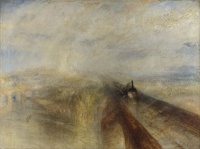Steam engine
From The Art and Popular Culture Encyclopedia
|
He has an arm, an iron arm Destroy King Steam, the Moloch wild, --King Steam (1812) "In 1814 The Times in London was for the first time printed by automatic, steam powered presses built by the German inventors Friedrich Koenig and Andreas Friedrich Bauer, signaling the begin of making newspapers available to a mass audience."--Sholem Stein |
|
Related e |
|
Featured: |
A steam engine is a heat engine that performs mechanical work using steam as its working fluid.
Steam engines are external combustion engines, where the working fluid is separate from the combustion products. Non-combustion heat sources such as solar power, nuclear power or geothermal energy may be used. Water turns to steam in a boiler and reaches a high pressure. When expanded through pistons or turbines, mechanical work is done. The reduced-pressure steam is then condensed, and it is pumped back into the boiler. The ideal thermodynamic cycle used to analyze this process is called the Rankine cycle. Some practical steam engines discard the low-pressure steam instead of condensing it for reuse.
The idea of using boiling water to produce mechanical motion has a long history, going back about 2,000 years. Early devices were not practical power producers, but more advanced designs producing usable power have become a major source of mechanical power over the last 300 years, beginning with applications for removing water from mines using vacuum engines. Subsequent developments used pressurized steam and converted linear to rotational motion which enabled the powering of a wide range of manufacturing machinery. These engines could be sited anywhere that water and coal or wood fuel could be obtained, whereas previous installations were limited to locations where water wheels or windmills could be used. Significantly, this power source would later be applied to vehicles such as steam tractors and railway locomotives. The steam engine was a critical component of the Industrial Revolution, providing the prime mover for modern mass-production manufacturing methods. Modern steam turbines generate about 90% of the electric power in the United States using a variety of heat sources.
In general usage, the term 'steam engine' can refer to integrated steam plants such as railway steam locomotives and portable engines, or may refer to the machinery alone, as in the beam engine and stationary steam engine. Specialized devices such as steam hammers and steam pile drivers are dependent on steam supplied from a separate boiler.
See also
- Aeolipile
- Compound locomotive
- Geared steam locomotive
- Giovanni Battista della Porta
- History of steam road vehicles
- Lean's Engine Reporter
- List of steam museums
- List of steam fairs
- List of steam technology patents
- Live steam
- Marine steam engine
- Model steam engine
- Portable engine
- Reciprocating engine
- Salomon de Caus
- Steamboat
- Steam locomotive
- Steampunk
- Steam power during the Industrial Revolution
- Steamroller
- Steam tricycle
- Steam turbine
- Still engine
- Timeline of steam power
- Traction engine
- Valve gear


